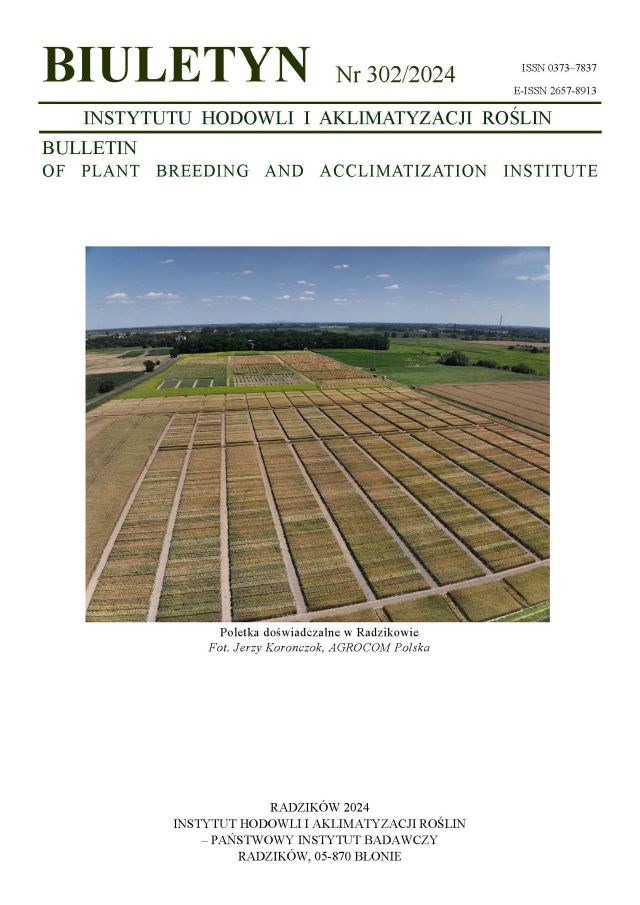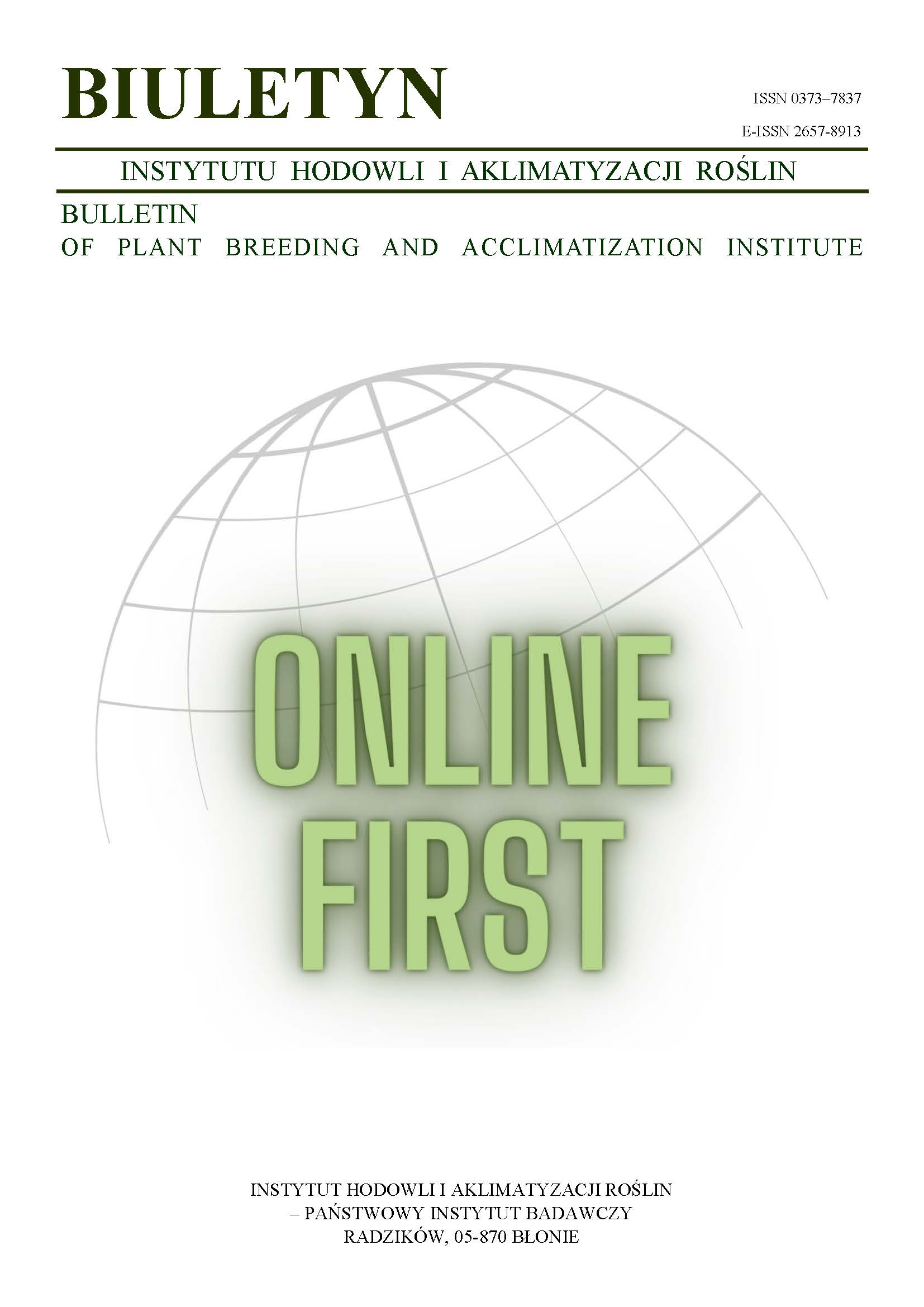Analysis of genotype-environment interaction for winter wheat using graphical GGE biplot method
Part II. Groups of environments and stability of genotypes
Paweł Jankowski
pawel_jankowski@sggw.plKatedra Biometrii, Szkoła Główna Gospodarstwa Wiejskiego w Warszawie (Poland)
Andrzej Zieliński
Katedra Biometrii, Szkoła Główna Gospodarstwa Wiejskiego w Warszawie (Poland)
Wiesław Mądry
Katedra Biometrii, Szkoła Główna Gospodarstwa Wiejskiego w Warszawie (Poland)
Abstract
GGE biplot is a graphical method of analysis of the so-called GGE effects, i.e. main genotype effects combined with genotype-environment interaction effects. In the paper the GGE biplot method has been used in order to interpret the 2004 data for grain yield of the winter wheat variety trials in western Poland. First, a kind of the cluster analysis of tested environments has been presented. It led to an indication of the so-called multi-environments characterized by the similar genotype-environment interaction with all analyzed genotypes. Next, the method has been applied to the genotype stability analysis. Genotypes closest to the so-called ideal genotype defined as stable and with highest average yield in all environments have been found.
Keywords:
biplot, genotype-environment interaction, GGE effects, stability of genotypes, winter wheatReferences
Annicchiarico P. 2002. Genotype environment interactions — challenges and opportunities for plant breeding and cultivar recommendations. FAO Plant Production and Protection Paper–174. Food and Agriculture Organization of the United Nations, Rome.
Google Scholar
Basford H. E., Cooper M. 1998. Genotype environment interactions and some considerations of their implications for wheat breeding in Australia. Austr. J. Agric. Res. 49: 153 — 174.
DOI: https://doi.org/10.1071/A97035
Google Scholar
Becker H. C., Leon J. 1988. Stability analysis in plant breeding. Plant Breeding 101, 1 — 23.
DOI: https://doi.org/10.1111/j.1439-0523.1988.tb00261.x
Google Scholar
Braun H. J., Rajaram S., van Ginkel M. 1996. CIMMYT’s approach to breeding for wide adaptation. Euphytica 92, 175 — 183.
DOI: https://doi.org/10.1007/BF00022843
Google Scholar
Caliński T., Czajka S., Kaczmarek Z. 1987 a. A model for the analysis of a series of experiments repeated at several places over a period of years. I. Theory. Biul. Oceny Odmian 17-18: 7 — 33.
Google Scholar
Caliński T., Czajka S., Kaczmarek Z. 1987 b. A model for the analysis of a series of experiments repeated at several places over a period of years. II. Example. Biul. Oceny Odmian 17-18: 35 — 71.
Google Scholar
Caliński T., Czajka S., Kaczmarek Z. 1997. A multivariate approach to analysing genotype-environment interactions. In: Advances in Biometrical Genetics. Krajewski P., Kaczmarek Z. (Ed), Poznań: 3 — 14.
Google Scholar
Caliński T., Czajka S., Kaczmarek Z., Krajewski P., Siatkowski I. 1995. SERGEN — a computer program for the analysis of series of variety trials. Biuletyn Oceny Odmian 26-27: 39 — 41.
Google Scholar
Gabriel K. R. 1971. The biplot-graphic display of matrices with application to principal component analysis. Biometrika 58: 453 — 467.
DOI: https://doi.org/10.1093/biomet/58.3.453
Google Scholar
Jankowski P., Zieliński A., Mądry W. 2006. Analiza interakcji genotyp-środowisko dla pszenicy ozimej z wykorzystaniem metody graficznej biplot typu GGE. Część I. Podstawy teoretyczne. Biul. IHAR 240/241: .
Google Scholar
Kang M. S. 2002. Genotype-environment interaction: Progress and prospects. In: Quantitative genetics, genomics and plant breeding. M. S. Kang (Ed), CAB International Wallingford, UK: 221 — 243.
DOI: https://doi.org/10.1079/9780851996011.0221
Google Scholar
Lin C. S., Binns M. R. 1994. Concepts and methods for analyzing regional trial data for cultivar and location selection. Plant Breeding Reviews 12: 271 — 297.
DOI: https://doi.org/10.1002/9780470650493.ch10
Google Scholar
Lipkovich H., Smith P. 2002. Biplot and singular value decomposition Macros for Excel©. J. of Statist. Software 7 (5): 1 — 15.
DOI: https://doi.org/10.18637/jss.v007.i05
Google Scholar
Mądry W., Kang M. S. 2005. Scheffé-Calinski and Shukla Models: Their Interpretation and Usefulness in Stability and Adaptation Analyses. Journal of Crop Improvement, Vol. 14, 1/2: (w druku).
DOI: https://doi.org/10.1300/J411v14n01_13
Google Scholar
Mądry W., Drzazga T., Laudański Z., Rajfura A., Krajewski P., Sieczko L. 2003. Statystyczna analiza adaptacji genotypów pszenicy ozimej na podstawie mieszanych modeli genotypowo-środowiskowych. Fragmenta Agronomica 80: 10 — 31.
Google Scholar
Rao C. R. 1982. Modele liniowe statystyki matematycznej. PWN, Warszawa: 60.
Google Scholar
Yan W. 2001. GGE biplot — a Windows application for graphical analysis of multienvironment trial data and other types of two-way data. Agron. J. 93: 1111 — 1118.
DOI: https://doi.org/10.2134/agronj2001.9351111x
Google Scholar
Yan W. 2001-2004. Strona World Wide Web: http://www.ggebiplot.com/biplot.htm.
Google Scholar
Yan W., Hunt L.A., Sheng Q., Szlavnics Z. 2000. Cultivar evaluation and mega-environment investigation based on the GGE biplot. Crop Sci. 40: 597 — 605.
DOI: https://doi.org/10.2135/cropsci2000.403597x
Google Scholar
Yan W., Hunt L.A. 2001. Interpretation of genotype-environment interaction for winter wheat yield in Ontario. Crop Sci. 41, 19 — 25.
DOI: https://doi.org/10.2135/cropsci2001.41119x
Google Scholar
Yan W., Kang M. S. 2003. GGE biplot analysis: a graphical tool for breeders, geneticists and agronomists. CRC Press, Boca Raton, FL.
DOI: https://doi.org/10.1201/9781420040371
Google Scholar
Zieliński A., Jankowski P., Mądry W. 2005. Biplot typu GGE jako narzędzie do graficznej analizy danych z serii doświadczeń z genotypami. XXXV Coll. Biom., 207 — 224.
Google Scholar
Authors
Paweł Jankowskipawel_jankowski@sggw.pl
Katedra Biometrii, Szkoła Główna Gospodarstwa Wiejskiego w Warszawie Poland
Authors
Andrzej ZielińskiKatedra Biometrii, Szkoła Główna Gospodarstwa Wiejskiego w Warszawie Poland
Authors
Wiesław MądryKatedra Biometrii, Szkoła Główna Gospodarstwa Wiejskiego w Warszawie Poland
Statistics
Abstract views: 28PDF downloads: 8
License
Copyright (c) 2006 Paweł Jankowski, Andrzej Zieliński, Wiesław Mądry

This work is licensed under a Creative Commons Attribution-ShareAlike 4.0 International License.
Upon submitting the article, the Authors grant the Publisher a non-exclusive and free license to use the article for an indefinite period of time throughout the world in the following fields of use:
- Production and reproduction of copies of the article using a specific technique, including printing and digital technology.
- Placing on the market, lending or renting the original or copies of the article.
- Public performance, exhibition, display, reproduction, broadcasting and re-broadcasting, as well as making the article publicly available in such a way that everyone can access it at a place and time of their choice.
- Including the article in a collective work.
- Uploading an article in electronic form to electronic platforms or otherwise introducing an article in electronic form to the Internet or other network.
- Dissemination of the article in electronic form on the Internet or other network, in collective work as well as independently.
- Making the article available in an electronic version in such a way that everyone can access it at a place and time of their choice, in particular via the Internet.
Authors by sending a request for publication:
- They consent to the publication of the article in the journal,
- They agree to give the publication a DOI (Digital Object Identifier),
- They undertake to comply with the publishing house's code of ethics in accordance with the guidelines of the Committee on Publication Ethics (COPE), (http://ihar.edu.pl/biblioteka_i_wydawnictwa.php),
- They consent to the articles being made available in electronic form under the CC BY-SA 4.0 license, in open access,
- They agree to send article metadata to commercial and non-commercial journal indexing databases.
Most read articles by the same author(s)
- Joanna Ukalska, Krzysztof Ukalski, Tadeusz Śmiałowski, Wiesław Mądry, An examination of diversity and interrelationships among traits in a winter wheat (Triticum aestivum L.) germplasm collection by multivariate methods. Part II. Principal component analysis using the phenotypic and genotypic correlation matrix , Bulletin of Plant Breeding and Acclimatization Institute: No. 249 (2008): Regular issue
- Dariusz Gozdowski, Wiesław Mądry, Zdzisław Wyszyński, Analysis of correlation and path coefficients in evaluation of relationships between grain yield and its components of two spring barley cultivars , Bulletin of Plant Breeding and Acclimatization Institute: No. 248 (2008): Regular issue
- Wiesław Mądry, Dariusz Gozdowski, A history of the development of statistical methods for designing and analyzing agricultural experiments in the world and in Poland , Bulletin of Plant Breeding and Acclimatization Institute: No. 288 (2020): Regular issue
- Krzysztof Ukalski, Joanna Ukalska, Tadeusz Śmiałowski, Wiesław Mądry, An examination of diversity and interrelationships among traits in a winter wheat (Triticum aestivum L.) germplasm collection by multivariate methods. Part I. Phenotypic and genotypic correlations , Bulletin of Plant Breeding and Acclimatization Institute: No. 249 (2008): Regular issue
- Marcin Studnicki, Wiesław Mądry, Tadeusz Śmiałowski, Multivariate analysis of phenotypic diversity in Polish spring wheat collection , Bulletin of Plant Breeding and Acclimatization Institute: No. 252 (2009): Regular issue
- Anna Rajfura, Wiesław Mądry, Tadeusz Drzazga, Marzena Iwańska, The clustering of locations based on multi-environment trials with different cultivars across years using the SEQRET package. Part II. An example for grain yield from winter wheat pre-registration trials , Bulletin of Plant Breeding and Acclimatization Institute: No. 250 (2008): Regular issue
- Adriana Derejko, Wiesław Mądry, Dariusz Gozdowski, Jan Rozbicki, Jan Golba, Mariusz Piechociński, Marcin Studnicki, The influence of cultivar, location, crop management intensities, and their interactions on winter wheat yield in post-registration multi-environment trials (PDO) , Bulletin of Plant Breeding and Acclimatization Institute: No. 259 (2011): Regular issue
- Dariusz Gozdowski, Wiesław Mądry, Characteristics and empirical comparison of simple and complex path analysis in grain yield determination by yield - related traits. Part I. Presentation of methods , Bulletin of Plant Breeding and Acclimatization Institute: No. 249 (2008): Regular issue
- Stanisław Pluta, Wiesław Mądry, Edward Żurawicz, Marcin Kozak, Statistical assessment of determination of fruit yield in blackcurrant (Ribes nigrum L.) by two multiplicative yield components , Bulletin of Plant Breeding and Acclimatization Institute: No. 249 (2008): Regular issue
- Jakub Paderewski, Wiesław Mądry, Wiesław Pilarczyk, Tadeusz Drzazga, Retrospective study of yield response to environmental conditions in winter wheat cultivars using combined AMMI and cluster analysis to incomplete data: genetic progress for adaptability , Bulletin of Plant Breeding and Acclimatization Institute: No. 250 (2008): Regular issue














